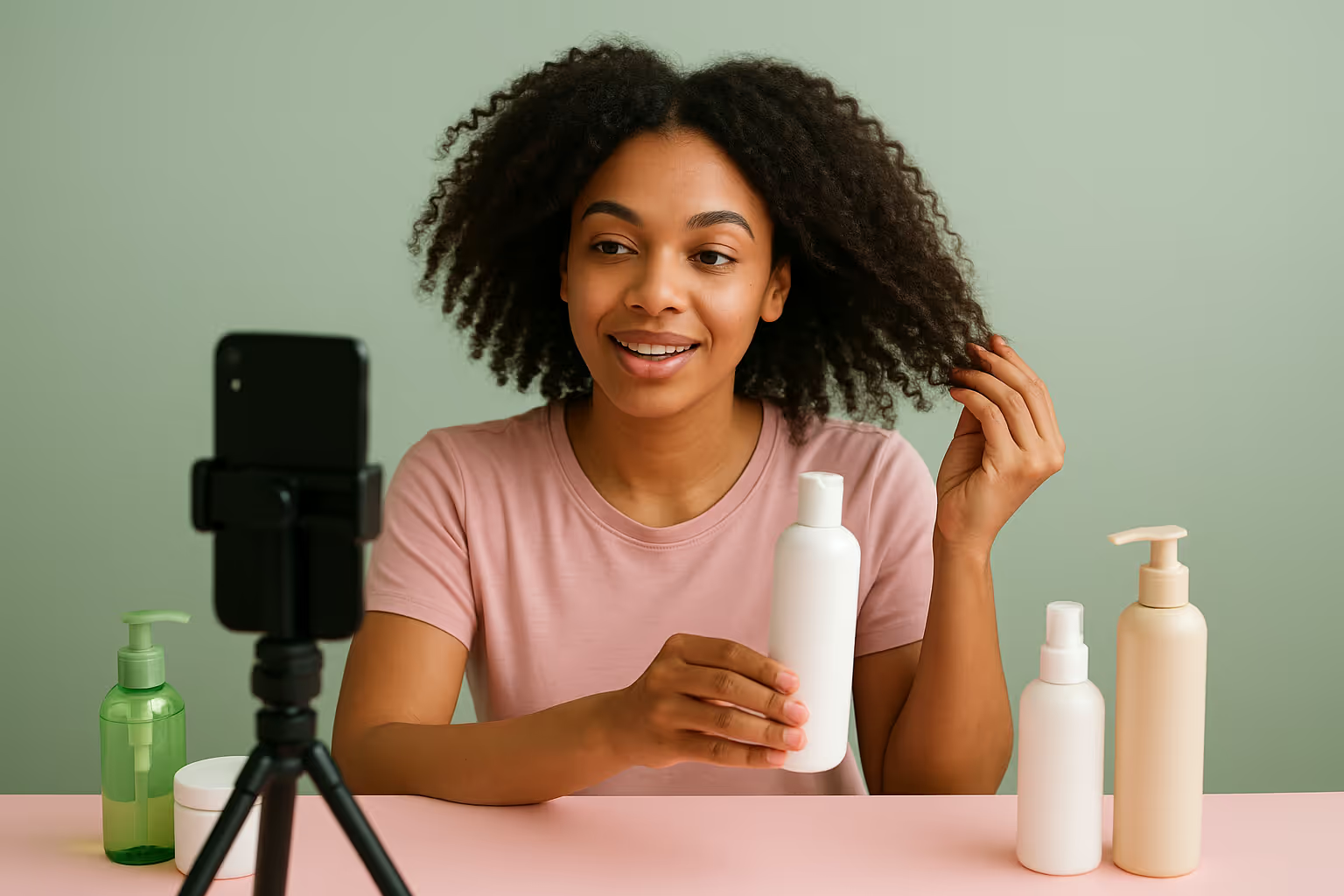
Successfully promoting shampoo on social media requires understanding both the beauty industry's unique dynamics and each platform's specific audience behaviors.
With the global hair care market projected to reach over $102 billion by 2026, brands must craft digital strategies that resonate.
Consumers are no longer swayed by generic ads, they’re looking for authentic recommendations and transparent ingredient information before making purchase decisions.
In this guide on how to promote shampoo on social media, you’ll learn practical strategies to stand out in a crowded digital landscape and drive real engagement.
Key Strategies for Promoting Shampoo on Social Media
Promoting shampoo effectively on social media demands a strategic approach combining authentic content creation, targeted audience engagement, and platform-specific tactics.
Create Compelling Visual Content That Converts
Visual storytelling forms the backbone of successful shampoo promotion because hair transformations provide immediate, compelling proof of product effectiveness.
Focus on content that showcases real results while addressing specific hair concerns your target audience faces.
User-generated content amplifies credibility beyond traditional advertising. When potential customers see others with similar hair types achieving results, conversion rates typically increase by 20-30%.
Encourage customers to share their hair journeys using branded hashtags. Create campaigns around specific challenges:
- Frizz control and smoothing treatments
- Color protection and vibrancy maintenance
- Scalp health and dandruff solutions
- Volume enhancement for fine hair
- Damage repair for chemically treated hair
Educational content builds authority while providing genuine value. Many consumers struggle with understanding sulfates, parabens, and natural alternatives.
Break down complex ingredient benefits, demonstrate proper application techniques, and explain how different formulations address various hair concerns.
Leverage Platform-Specific Features for Maximum Reach
Each social media platform offers unique opportunities for shampoo promotion. Success requires tailoring content to match platform culture and user behavior patterns rather than posting identical content everywhere.

Instagram excels at aspirational content mixed with authentic relatability. Stories work particularly well for showing daily hair routines, quick application tutorials, and behind-the-scenes content.
Reels focusing on hair transformations, styling techniques, or ingredient spotlights often achieve higher organic reach than static posts. The platform's shopping features enable direct product discovery and purchase.
TikTok
TikTok demands authentic, trend-driven content that feels native to the platform. Hair care brands succeed by participating in relevant challenges, creating educational series about different hair types, or partnering with creators who genuinely use products.
The algorithm rewards consistency and engagement over production quality, making it accessible for brands with smaller budgets.
YouTube
YouTube allows for comprehensive educational content that builds deeper relationships with potential customers. Detailed product reviews, ingredient breakdowns, and long-form tutorials perform well because many consumers research hair care products extensively before purchasing.
This platform works exceptionally well for addressing complex questions and building long-term brand authority.
Facebook's strength lies in community building around shared hair challenges. Groups focused on specific hair types, styling methods, or concerns create opportunities for organic product mentions and recommendations. The platform's older demographic often has more purchasing power and demonstrates stronger brand loyalty once trust is established.
Build Strategic Influencer Partnerships
Influencer partnerships require strategic selection beyond simple follower counts. Micro-influencers with 10,000-100,000 followers often deliver superior engagement rates and more authentic product integration compared to macro-influencers.
Focus on creators whose hair type, concerns, and audience demographics align closely with target market characteristics. Someone promoting products for curly hair should have curly hair and understand the unique challenges that come with it.
Successful partnerships prioritize authenticity over obvious sponsorships. The most effective campaigns emerge when influencers genuinely adopt products into their existing routines rather than creating obvious advertisements. Allow creative freedom while maintaining brand guidelines.
Consider these partnership approaches for maximum impact:
- Long-term collaborations that build audience trust over time
- Seasonal campaigns that align with specific hair care needs
- Product launch partnerships that leverage existing creator relationships
- Educational content collaborations that provide mutual value
Connecting with Your Hair Care Audience

Hair care is deeply personal and often tied to self-confidence and cultural identity. Successful brands recognize these emotional connections and create content that supports customers' entire hair journey rather than just promoting products.
Different hair types require completely different approaches. Fine hair struggles with volume and greasiness, while thick hair battles frizz and dryness.
Curly hair needs moisture and definition, while straight hair seeks smoothness and shine. Tailor messaging to address these specific concerns rather than using generic benefits.
Cultural nuances matter too. Natural hair movements, protective styling, and cultural hair rituals strongly shape purchasing behavior. Brands that honor these practices while offering relevant solutions build lasting loyalty.
Using private label dropshipping makes it easier for emerging brands to offer tailored products without heavy inventory risk. Combine that with a reliable fulfillment solution and smart e-commerce integration, and you can scale quickly while staying responsive to diverse customer needs.
Optimizing Performance Through Data and Analytics
Advanced targeting goes beyond basic demographic classifications to create meaningful audience segments. Hair type, lifestyle factors, and purchase behaviors generate more effective targeting than age and gender alone.
Lookalike audiences based on existing customers consistently outperform broad demographic targeting across most platforms.
Upload customer email lists to create similar audience segments that share characteristics with current buyers. These audiences typically demonstrate higher engagement rates and superior conversion potential.
Retargeting campaigns capture users who showed initial interest but didn't complete purchases. Create specific campaign sequences for different audience behaviors:
- Website visitors who viewed product pages but didn't purchase
- Video watchers who engaged with educational content
- Social media users who commented or shared posts
- Email subscribers who haven't made their first purchases
Insider's Tip: The Ingredient Spotlight Strategy
Most brands focus on finished product benefits, but savvy marketers highlight individual ingredients and their specific functions. Create content series featuring single ingredients like biotin, keratin, or argan oil.
Explain the science, show before-and-after results, and position products as superior formulations. This strategy works because consumers increasingly research ingredients independently.
When they search for specific ingredients, branded content appears alongside educational results. Partner with cosmetic chemists or trichologists to add scientific credibility to ingredient-focused content.
Their expertise elevates brand authority while providing educational value that consumers actively seek. These partnerships often generate shareable content that extends reach beyond immediate followers.
Taking Action on Social Media Success
Implementing these strategies requires consistent execution over perfect planning. Start with one platform and master its unique dynamics before expanding. Focus on creating valuable content that meets real customer needs while naturally highlighting product benefits.
Track performance metrics tied to business goals, not just vanity metrics. Test different content types, posting schedules, and audience segments systematically. Document what works and scale successful tactics across platforms.
The hair care social media landscape evolves constantly, so adapt proven strategies while keeping authentic connections with your audience.
FAQ
Related blogs

Influencer Pricing Calculator: Find Your Fair Rate for Posts, Reels & Stories
.avif)
How To Market Pet Products Through Storytelling: Win Attention, Build Trust, and Boost Sales Naturally
.avif)
How To Market Coffee To Gen Z: The High-Impact Blueprint Every Brand Needs
.avif)

